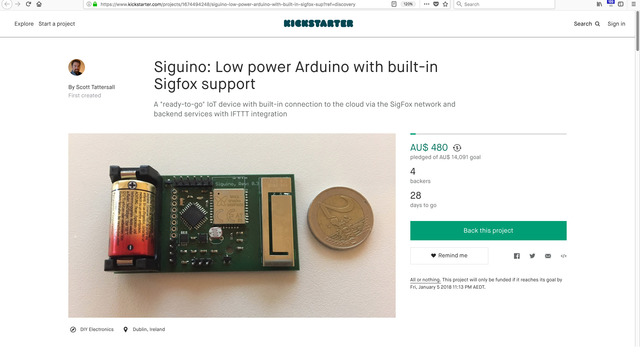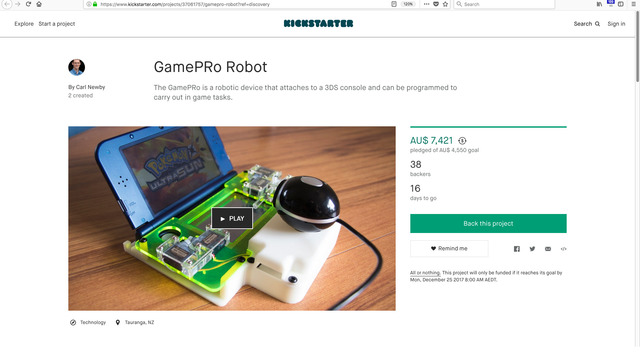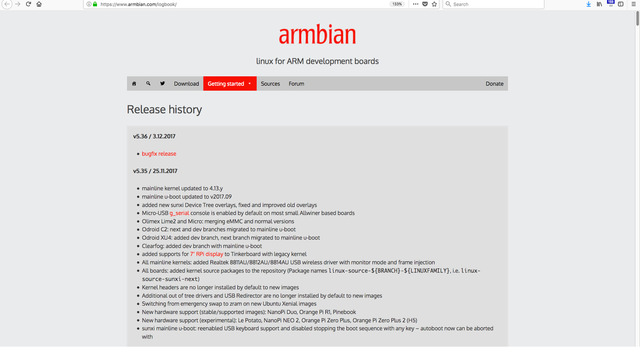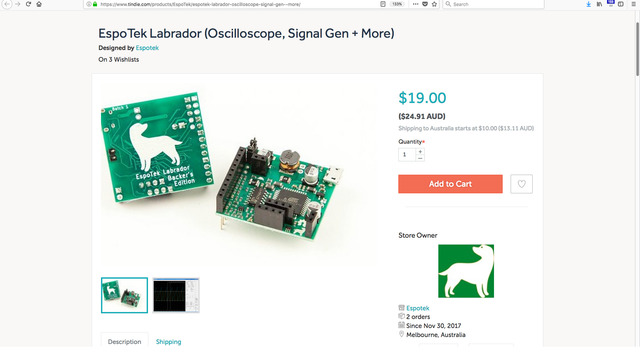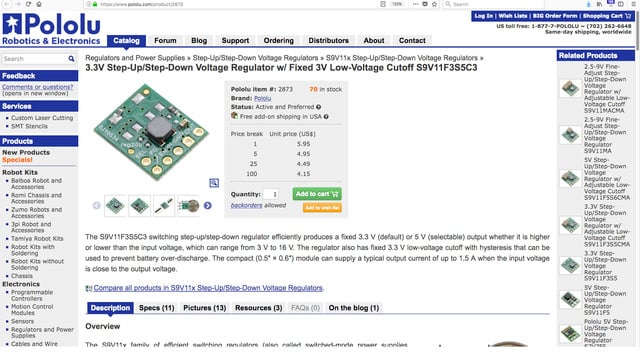Weekly Roundup #48 - New Maker Products // News
This week’s Weekly Roundup is chock full of SBCs and I’m not going to mention that word that flags my videos with YouTube as being inappropriate.
Crowd Funding
KickStarter
First up on Kickstarter …
EEVblog 121GW Multimeter
Dave Jones from EEVBlog has an upgrade on his popular multi-meter. In conjunction with UEI Test Instruments he’s added some really cool features missing from multi-meters such as Bluetooth and SD card. So, you’ll be able to log measurements over time to the SD card. The mobile app can also view several multi-meters at once and display a pretty little graph for you.Fantastic! Not only that, but it has a 15v diode test voltage, Low Burden voltage, VA power measurement, .05% accuracy, auto-hold and bar graph display running a hackable STM32 off 4 AA batteries. He’s releasing it as OpenHardware and OpenSource.
Siguino: Low power Arduino with built-in Sigfox support
This next campaign is for the Siguino which is a board running an ATmega328P and SFMR10 SigFox module. It also has FTDI and GPIO header pins, temperature, light and 9DOF IMU sensors powered from a single coin cell battery. The creator claims an uptime of 6 months sending messages every 15 minutes or 1 year sending daily.IPTalker video IP intercom with raspberry PI
Another Pi hat. This one allows you to setup a cheap full-duplex intercom over Ethernet. It has relay outputs for control of 12v devices, input buttons and camera interface allowing you to setup a device to device, or device to internet intercom. You can also configure it to work with existing PBXs allowing you to setup a phone to device intercom. Nice.Raspberry Pi Zero Docking Hub
This next one was sent to me by one of my Patrons, (thanks Mike!). If you already own a PiZero, then you can upgrade it to effectively a Pi3 with this docking hub. It breaks out the PiZero audio and also has a USB hub providing an additional 5 USB ports, a Realtek 100MbE chip and on-board power supply. Connectivity is via pogo-pins, so no soldering required. I’m not completely sold on this one. It’s a good idea, but for the price tag of AU$68 I could get a Pi3.Optically Isolated USB to Serial Adapter
This next one is for an optically isolated USB board. If you’re hacking around with your own PCBs, then I’d strongly suggest looking into one of these. I’ve already had one computer die on me due to USB and power related issues.GamePRo Robot
It had to happen! For those really lazy people you can now pickup a game playing robot that attaches to your Nintendo 3DS.Oscilloscope, Multimeter & Logger that Fits in Your Pocket!
Pokit is back again!PiTalk - IOT enabled & Modular SmartPhone for Raspberry Pi
The PiTalk is up on Kickstarter. This is a board that converts your Pi into a fully fledged mobile phone. Has on-board LDO for power, Quectel UC15 mobile module and breaks out audio and USB. You can use it for voice calls, SMS and data connections. Nice.PCBite 2.0
Working with PCBs can be a fiddly business. I often use BluTak to hold things steady while probing, but this next one looks cool. The PCBite connects magnetically to a base plate and has a spring clip that can stabilize PCBs. There’s also a flexible wire probe with magnetic base, so you can keep probes connected freeing up your hands.Neutrino 3.0: The 32-bit Arduino Zero compatible!
Rabid Prototypes are back on Kickstarter with the Neutrino 3.0. This one contains the SAMD21, which is essentially an Arduino Zero, but in a small 36 by 18 mm package. It breaks out all the good stuff from the SAMD21 and the pre-flashed firmware will work with the Arduino IDE or it also has on-board SWD for programming without the Arduino IDE.Gameduino 3
Gameduino is back on Kickstarter. Version 3 of this Arduino shield now has an FT810 graphics processor which is backwards compatible with the FT800. It delivers 4x more power, allowing 30 FPS compressed video playback on a 480 by 272 LCD touch screen.ExControl Shield , Industrial Arduino Mkr
ExControl is an industrial PCB with a socket for the Arduino MKR PCB series. It has 7 digital inputs and 7 digital outputs that are isolated, 8KB EEPROM, DS2331 RTC and the extension board adds another 8 inputs and 8 outputs all rated at 12v.Precision Voltage Reference
If you ever need a high precision voltage reference, then this DIY kit will provide a steady 5v at +/- .005 volt resolution from two AA batteries. Note he has said that fresh batteries are required to maintain that resolution.Multichannel intelligent high-power LED driver
This next one is a little late for your Christmas LED lights. It’s a board designed around 6 of the Meanwell LDD-H driver modules which are DC to DC converters. Allows you to drive up to 84 LEDs at 1.5A with a maximum rating of 375W and allows PWM control over the 6 channels.The Arduino Compatible RFID Reader Module With EEPROM
Patrick Thomas Mitchell is back with his 25th Kickstarter. This one is a simple RFID Arduino shield. From what I can see, instead of a dedicated RFID chip, he’s using a PIC MCU running off Aplus flash to emulate the RFID comms. Interesting.LattePanda Alpha - Soul of a MacBook in a Pocket-sized Board
Next up on Kickstarter the LattePanda guys are back. They must have seen my gag on shoe-horning OSX onto a LattePanda and taken it seriously as there’s now a campaign for the LattePanda Alpha and Delta.What makes these the ultimate Hackable computer?
Well, first of all the Alpha runs an Intel i7 Core M3 CPU, which is exactly the same as the latest MacBook and the Delta runs the Celeron N4100. They also have on-board 64 or 32G eMMC, 8 or 4G DDR4 RAM, two M.2 ports, GbE, WiFi, Bluetooth, up to three graphics outputs over HDMI, eDP and touch display, USB-C, 3x USB3.0 ports, RTC, microSD slot, audio jacks and an ATmega32U4, (Arduino Leonardo), pushing out 50 GPIOs all in a small footprint that is smaller than an iPhone Plus. The Alpha is up for US$289 and the Delta for around US$130.
Holy Cow Batman!
IndieGoGo
I was almost not going to bother checking on IndieGoGo, until I found …
Renegade
… the Renegade SBC from Libre Computer. They have three models all housed in the familiar Pi form factor running an RK3328 SoC, GbE, USB2.0, USB3.0, eMMC socket, SD slot, IR receiver and all the usual GPIOs. The three different models give you either 1, 2 or 4GB DDR4 RAM.Crowd Supply
IQ Drone
Over at CrowdSupply there’s the IQ Drone in pre-launch. This is a motor with integrated controller which claims to bring professional grade motor control to your drones. It provides features such as anti-cogging, reduced motor vibration, sinusoidal and trapezoidal commutation, which gives you efficiency or increased power, freewheeling, braking and other cools things. Comms is over serial, DShot or standard PWM.GroupGets
And there’s nothing new on GroupGets this week.
Honorable mentions
Jetson TX1 Developer Kit SE
Nvidia are offering the Jetson TX1 at a discounted price for developers for US$199. All you have to do is sign up and provide a blood sample to get access to the limited, “one unit only per person” price. OK, maybe not blood sample, but close enough.Coin cell competition
Over at HackADay, they are running a Coin cell competition, with three categories.The Lifetime Award for the longest running project.
The Supernova Award for the most interesting project.
and the Heavy Lifting Award for anyone who can lift a piano with a coin cell. Lifting a piano?
VAMRS Sapphire SBC
This next one I picked up from LinuxGizmos. It’s a board made by a company called VAMRS. VAMRS? I think you pronounce it like farmers, but with a V. It’s an RK3399 based SBC with 4G DDR3 RAM, 8G eMMC, SD slot, GbE, USB3.0 ports, 40 pin Pi GPIO header and a 314 pin MXM connector pushing out a whole lot more.VAMRS Sapphire Excavator
It’s designed to slot into the fantastically named Excavator, which has has two HDMI ports, WiFi, Bluetooth, GbE, and PCIe interfaces.NanoPC-T3 Plus
The Friendly guys have released another SBC called the NanoPC-T3 Plus. Like the previous version it runs the same Samsung SoC, but now has 2G DDR3 RAM and 16G eMMC and gains an extra USB port. Apart from that, everything else appears the same.iWave Systems Renesas SBC
This next one I picked up from CNXsoftware, which is a new SBC from iWave Systems. Based on the almost Pi form factor, it runs the dual or single core Cortex-A7 Renesas RZ/G1C and has 512MB DDR3 RAM expandable to 2G, 8G eMMC and all the usual I/O stuff, except it has an additional 40 pin and 20 pin header on top of the standard Pi GPIO header. All powered off a 5v, 2A supply from one of those micro USB connectors.MyIR MYC-Y6ULX
Over at MyIR, they have released an US$18 module based on the i.MX6 UL. Breaking out on the 1mm pitch castellated edge connectors are 140 pins of GPIO goodness, but this new module gives you WiFi capabilities. Nice option if you want to be able to run a WiFi enabled Linux in a tiny package, but I’ve heard that MyIR documentation isn’t that good. So Caveat Emptor.Google Tensorflow Kit
Google released the Tensorflow earlier in the year, which brings vision machine intelligence to the Maker. Well now, for only US$45 you can pre-order a kit from [EDIT: AdaFruit, DiGiKey and] Micro-center containing a Pi bonnet running the Movidius MA2450 processor, camera, lens, piezo, buttons and bits of cardboard to make your own standalone box. All you need is a Pi Zero W and you can build your robot army in no time.Amazon DeepLens
And not to be out-gunned, Amazon have just released the AWS DeepLens, which is another machine learning device with a 4MP camera and an Apollo Lake series Intel SoC. So pretty grunty. It provides a fairly similar lineup to Google’s Tensorflow, but runs Amazon’s version of FreeRTOS.Amazon FreeRTOS
Amazon has a version of FreeRTOS? Yup, they certainly do. They’ve gone and taken FreeRTOS and added in enhancements such as AWS Cloud or Greengrass connectivity, security and OTA programming. FreeRTOS runs on pretty much all MCUs these days and good to see these sorts of enhancements being made available.RK3288 demise
Over at Reddit there’s a post about the demise of the RK3288. This is pretty interesting as the RK3288 has been around for only 4 years, has started to run on boards such as the TinkerBoard and RICO-3288 and only just started to gain some decent support for it. Is this true? Who knows? So far the only pointer is this Reddit post and nothing else.Armbian 5.35
The Armbian guys are busy with releases and there’s now a minor point release of version 5.35, which actually adds in support for a whole lot of SBCs. Boards such as NanoPi Duo, Orange Pi R1, Pinebook have stable releases, while experimental support has been added for Le Potato, NanoPi NEO 2, Orange Pi Zero Plus and Zero Plus 2. It also runs mainline kernel version 4.13 and an updated Uboot. Nice! So, if you want an image that works on a whole stack of boards go and fetch Armbian.Maker Shops
Tindie
Over at Tindie there’s just a few things …
Dual Axis Smart Solar Tracker
This kit is a solar tracker that contains an Arduino, servo motors, laser cut wood, and sensors. So all you need is a screwdriver and PC and you’re set.USB 3.1 Type-A power meter
Here’s another USB power meter. Runs the ATSAMD09 with OLED display. It has a voltage resolution of 100uV up to 10v and then 1mV resolution up to 25V with a 100uA current resolution. Can display voltage, current and power.Raspberry Pi Voltage shifter for WS2812
You might just get this delivered before Christmas if you’re quick. It’s a Pi hat that shifts voltages for the WS2812 Neopixels.GPS Referenced 1MHz RF generator
If you’re looking for a fairly stable 1GHz clock. This 1GHz GPS disciplined clock generator is pretty cheap. It can also be set for several other frequencies up to 10MHz, but no indication of the accuracy.LoFive
Back in Weekly Roundup #43 and also in MickMake Mail #21 there was the LoFive. Well, now Michael Welling has put it up on Tindie. You can also pick it up from GroupGets as well.Sigfox Castellated Breakout Board
Looking to get into SigFox? This castellated breakout board runs the Wisol WSSFM10R2 and also comes with 2 years free access to the SigFox network. It’s a 3.3v system and connectivity is over plain old UART.Adapter for ESP8285 Board
Back in Weekly Roundup #26 there was the ESP8285 module on BangGood. Well, this Tindie store has a breakout board for them.EspoTek Labrador
Good to see another Ozzie Maker. The Labrador was a CrowdSupply funded board that provides a 2 channel oscilloscope at 750Ksps, waveform generator and logic analyzer as well as a multi-meter capable of measuring voltage, current, resistance and capacitance. So, it’s not the world’s fastest scope, but certainly cheap and reliable.K.I.T.T. Knight Rider Blinky LED Badge
You’ve probably seen the ad for this next one by Dave Darko? There you go! Go and get one.RetroBall
Back in Weekly Roundup #40 there was the Retroball on Kickstarter. Well, now it’s up on Tindie. It’s a DIY kit allowing you to build your own game of pong. Oh, look! He’s another Ozzie Maker!Creltek 8 Channel Clock Generator
Another clock generator board, but this one is based on the Silicon Labs Si5331A, which is capable of generating clocks from 2.5KHz to 200MHz on 8 separate channels. Access is over 3.3v logic I2C.Creltek Video DAC
The same Tindie store also has a video DAC board, which converts 24bit RGB pixel data to an analog video signal. Supports up to 180MHz pixel clock rate over PAL or NTSC on composite, S-video or VGA. Runs off a 5v supply with 3.3v logic.hackaBLE
HackaBLE is another board based on the nRF52832 Bluetooth chip. Has all the usual goodies such as reset button and LDO, but comes in at a tiny 18 by 28mm castellated package.EEPROM Programmer Arduino Shield
If you’re in to retro kit, then one of these is damn handy. It’s a shield that allows you to program 28 pin DIP EEPROMs. Useful for updating some of the more recent hacked cartridges you can get these days.AdaFruit, Seeed, SparkFun, DFRobot, DigiKey
I2S Stereo Decoder - UDA1334A Breakout
Over at AdaFruit they have a breakout for the UDA1334 I2S stereo DAC. Logic levels and power can be either 3.3 or 5v and is capable of 96kHz at 24bit resolution.Beam Pluggable LED Boards
Beam is an end to end pluggable LED matrix that talks I2C back to a 3.3 or 5v micro. You can connect up to 4 of them together to give you 480 LEDs. After that I figure the power demand would be too high.USB Type-C PD controller IC
If you’re looking to build a board with a USB Type-C connector, I found this chip from STMicro. It’ll manage USB Type-C power sources or devices with a programmable 600mA power switch. Essentially, if you want to power your device from USB Type-C, then get one of these.Step-Up/Step-Down Voltage Regulators
Over at Pololu there’s a number of step up/down voltage regulators with fixed and variable voltage outputs from variable voltage inputs. They’re all essentially the same board based on the S9V11 series switching regulator, but with different components.Honorable mentions
A few bits and pieces that I didn’t include in my video.
MegaBattery – Portable mini powerwall station
A mini powerwall! “Portable mini Powerwall station with multiple input by power adapter, car adapter charging.”Emergency Electric Candle
Something for when your powerwall fails. “The Electric Candle powers on as soon as you open the lid. The light waits until it is dark before turning on. Powered by AA battery.”Imagipod 3D Printer
Another “High quality, affordable 3D printer.”Poly - Bio and Easy 3D Printer
And another “Portable, multi-tool, biodegradable, and battery powered.”Coding-Block! COBL, Learn and Make Whatever You Want
Teach your kids Cobol! No, wait… That’s Cobl.“Educational tools for students who want to expand their coding skills and parents that want to give them interesting coding lessons”



